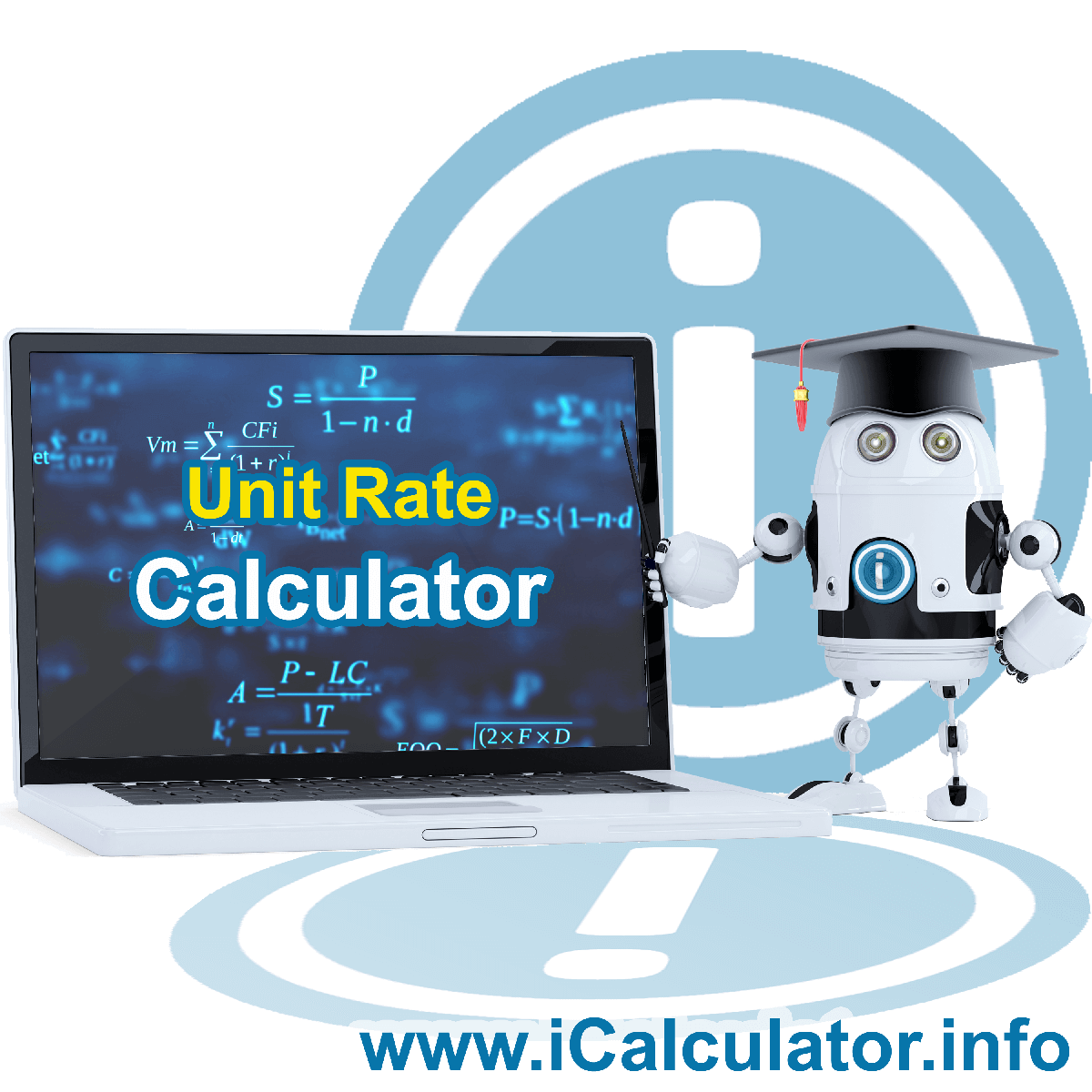Menu
Unit Rate Calculator
The unit rate calculator allows you to calculate the rate of units between 2 associated items. In affect, the unit rate calculator is a type of ratio calculator as the two figures are in direct relationship to each other. A common unit rate we are familiar with is kilometres per hour or miles per hours. Another example of a unit rate is the money shared in a group, this would give us euros per person, dollars per person or pounds per person. As these examples illustrate, the unit rate defines the single unit of value of a group of the same items.
| The Unit Rate is / |
| The Unit Rate Ratio is |
| Unit Rate as a fraction |
|---|
| Unit Rate = a/b Unit Rate = |
| Unit Rate Equation and Calculations |
| Unit Rate = a/b u1 / u2 Unit Rate = u1 / u2 Unit Rate = / |
| Unit Rate Ratio Equation and Calculations |
| Unit Rate Ratio = a:b Unit Rate Ratio = |
| Unit Rate Calculator Input Values |
| Quantity (a) = |
| Divided By (b) = |
| Units or items (u1) = |
| Units or items (u2) = |
If you found the Unit Rate Calculator useful, it would really help us if you could take a few seconds to provide a rating for the calculator and / or share to social media. This helps us to keep this calculator and our other calculators free for everyone to use, wherever they are in the world, however rich or poor.
Please provide a rating, it takes seconds and helps us to keep this resource free for all to use
People who used the Unit Rate Calculator also found the Significant Figures Calculator and tutorial useful.
Unit Rate Equation
where:
- a = a quantity of items, goods or products etc.
- b = a period of time, units or items that relates to quantity a
- u1 The name of the items, goods or products etc. defined at a
- u2 The name of the items, goods or products etc. defined at b
The unit rate can be expressed as a whole number or as a ratio, see the unit rate ratio equation below:
Unit Rate Ratio Equation
Why is the Unit Rate important?

Individual unit rates are incredibly important as they allow us to benchmark quantities and assess relative value in terms of share. For example, the number of apples we can buy with our income. We may pay more for an apple when purchased on its own but then pay less per Apple when buying 10 apples at the same time. In this example, the unit rate of apples per currency unit is higher for an individual purchase than when buying multiple apples. By knowing and calculating the unit rate of each, we can make a decision on the relative value for money on a purchase.
In business, knowing the unit rate is incredibly important. Each product/service will have a defined cost unit rate, a sales unit rate and profit unit rate. This allows businesses to benchmark how many items / services need to be sold in order to make balanced profits. Unit rates are particularly important in wholesale. Food products a good example. Supermarkets will likely buy apples in tonnes. The unit rate being cost per tonne. Within that, the supermarket will have an average number of apples per tonne. From that, they can calculate the individual Apple cost unit rate. In this simple example, there are numerous examples of different unit rates.
How is the Unit Rate Calculated?
The unit rate is calculated using the unit rate formula:
How do I express a unit rate?
Unit rates are most commonly expressed as x per y, for example miles per hour, kilometres per hour, dog treat per Beagle (see example below) and so forth. This is however not the only way of expressing a unit rate. A unit rate can also be expressed as a ratio, as a fraction, as a fraction or as a divisible amount:
- 1 x per 2 y - A unit expressed as a statement, where x could be distance and y could be speed to provide a unit rate for the amount of distance travelled in a. Certain amount of time.
- 1:2 - A unit rate expressed as a ratio
- ½ - A unit rate expressed as a fraction
- 1/2 - A unit rate expressed as a divisible amount
Why is a unit rate like a ratio?
Let us first consider the unit rate formula again:
Let's insert some simple figures and use a simple scenario to illustrate how the unit rate calculation is a ratio. Let's say we have 5 Beagles (a type of dog if you haven't heard of Beagles) and you have 10 dog treats. We want to work out the unit rate which is the number of dog treats that each of our beagles will get to eat. Let's take a look at those figures
Unit Rate = 10/5
We want to know the number of dog treats that each Beagle will have, so, we divided our number of beagles (5) by 5 to give us one Beagle. As we have divided the denominator by 5, we must also divide the numerator by 5. 10 dog treats divided by 5 beagles gives us 2 dog treats per Beagle. So our Unit Rate is
2:1 is a direct ratio of 10:5, they are in fact equivalent ratios. If you haven't encountered equivalent ratios, you can read more and calculate equivalent ratios on our equivalent Ratio Calculator.